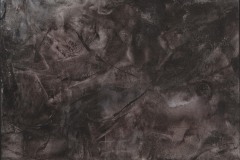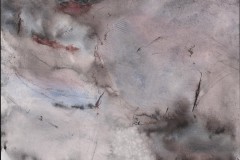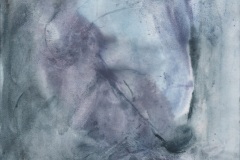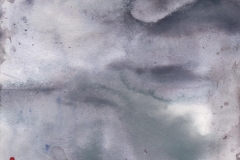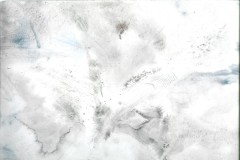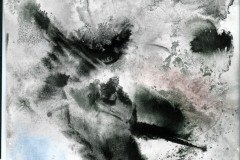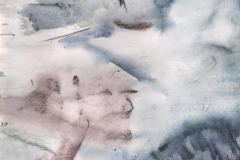Wadabstracten
De wadabstracten zijn het vaakst geëxposeerd. Het wad is zelf al een abstract, met de sterke contrasten in toon, de vele grijzen en bruinen die in een bepaald licht zilver en roze worden, de weerspiegeling van de lucht in de waterige plekken, de sporen van wormpjes en schelpdieren in de bodem met kleuren van modder en zand, het donkerbruin en groen van wier en het paynes grijs en grijsblauw van de bazaltblokken van dijk en pier… Ik kijk ernaar en verzamel kleuren en indrukken, en rangschik die thuis in een nieuwe configuratie, bijna altijd in aquarel. Als ik probeer ter plekke te schilderen wordt het niks: dan zit ik te dicht op de werkelijkheid.
Wetlandabstracts
The wetland-abstracts were my first venture into abstract painting, and have been exhibited most often. The wet-and-dry soil that appears when the tide is low is almost an abstract in itself: twenty different greys, the browns of mud and sand, the play of the sky in the wet parts, the trails of worms and shellfish, the dark green of algae and seeweed, the paynes grey, blue-grey and greengrey of the basalt that is used in dyke and pier… Daily I drink it all in, collecting impressions and colours, and then, at home, I rearrange them into a new configuration. When I try to paint on the spot, it does not work at all.
By the way, ‘Waddenzee’ is the name of the inland sea south of the islands in the north of Holland and Germany, the islands themselves are called ‘the Wadden’, so ‘wadabstract’ means an abstract of the Waddenzee, the water of which contains less salt than the sea, and large parts fall dry or halfdry with the tides. The name ‘wetlandabstract’ is less specific than ‘wadabstract’, but clearer for people who do not know the islands in the north of the Netherlands and Germany
Klik op de afbeeldingen / Click on the images

